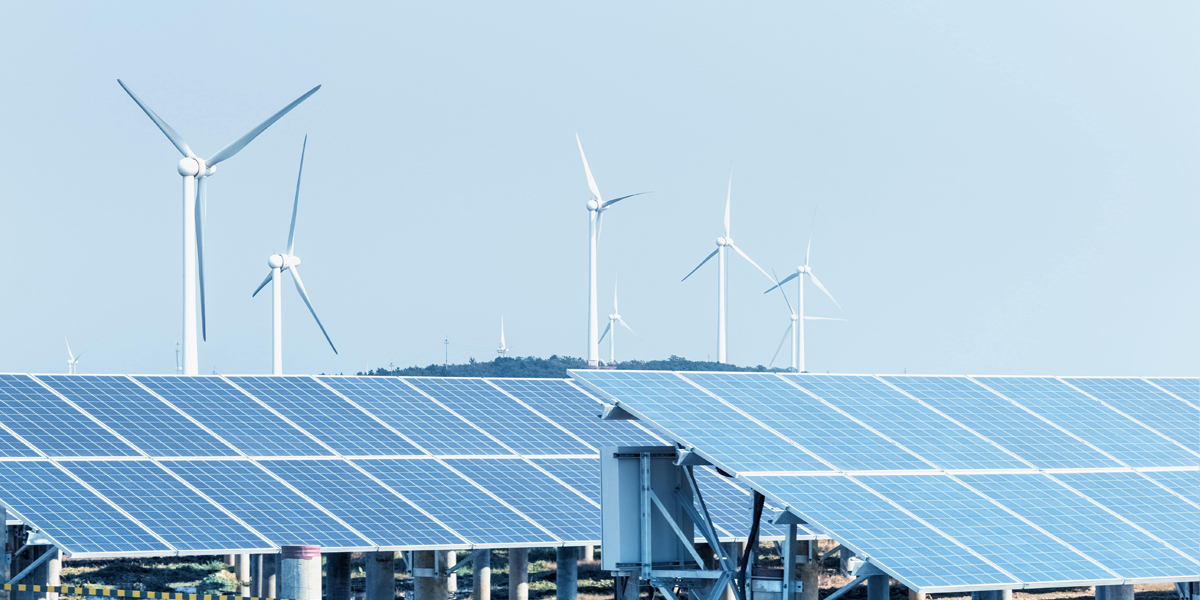
What is New Energy Industry?
The term "New Energy Industry" generally refers to the sector of the economy that focuses on the development, production, and utilization of alternative and renewable sources of energy. This industry encompasses technologies and practices that aim to reduce reliance on traditional fossil fuels, mitigate environmental impacts, and promote sustainable energy solutions. The New Energy Industry is a response to the challenges posed by climate change, resource depletion, and the need for cleaner and more sustainable energy sources.
Renewable Energy Sources:
Solar Energy: Harnessing sunlight to generate electricity through photovoltaic cells or concentrated solar power systems.
Wind Energy: Generating electricity by harnessing the kinetic energy of wind using wind turbines.
Hydroelectric Power: Utilizing the energy of flowing water to generate electricity through hydroelectric dams and plants.
Geothermal Energy: Extracting heat from the Earth's interior to produce electricity or for direct heating applications.
Biomass Energy: Converting organic materials such as wood, agricultural residues, and waste into biofuels or biogas.
Energy Storage and Management:
Battery Technology: Developing advanced energy storage solutions, such as lithium-ion batteries, for storing excess renewable energy and managing grid stability.
Grid Management: Implementing smart grid technologies for efficient distribution and management of electricity.
Energy Efficiency and Conservation:
Energy-efficient Technologies: Creating and implementing technologies and practices that reduce energy consumption in various sectors, such as buildings, transportation, and industry.
Energy Management Systems: Developing tools and systems to monitor, control, and optimize energy use in real time.
Electric Mobility:
Electric Vehicles (EVs): Designing and producing electric cars, buses, and other vehicles to replace traditional internal combustion engine vehicles.
Charging Infrastructure: Establishing networks of EV charging stations to support the adoption of electric vehicles.
Carbon Capture and Storage (CCS):
Developing technologies to capture carbon dioxide emissions from industrial processes and power plants, and storing them underground to mitigate climate change impacts.
Hydrogen Economy:
Utilizing hydrogen as a clean energy carrier, produced through renewable sources and used in fuel cells for electricity generation and as a transportation fuel.
Emerging Technologies:
Wave and Tidal Energy: Capturing energy from ocean waves and tides to generate electricity.
Advanced Nuclear Power: Developing safer and more efficient nuclear power technologies, including small modular reactors and fusion research.

What products are covered by the new energy industry?
Solar Energy Products:
Solar Panels: Photovoltaic panels that convert sunlight into electricity.
Solar Thermal Systems: Collectors and systems that use sunlight to heat water or air for residential, commercial, and industrial applications.
Solar Concentrators: Devices that concentrate sunlight to generate high-temperature heat or power.
Wind Energy Products:
Wind Turbines: Devices that convert wind energy into mechanical energy and then electricity.
Wind Turbine Components: Blades, nacelles, towers, and control systems used in wind turbines.
Hydropower Products:
Hydroelectric Generators: Equipment that converts the kinetic energy of flowing water into electricity.
Turbines and Generators: Components used in hydropower systems for power generation.
Geothermal Energy Products:
Geothermal Heat Pumps: Systems that use the Earth's natural heat for heating and cooling buildings.
Geothermal Power Plants: Facilities that convert geothermal heat into electricity.
Biomass Energy Products:
Biomass Boilers: Systems that burn organic materials to produce heat or electricity.
Biofuels: Fuels derived from biomass, used in transportation and heating.
Energy Storage Products:
Lithium-Ion Batteries: Rechargeable batteries used for energy storage in electric vehicles and grid systems.
Flow Batteries: Redox flow batteries used for large-scale energy storage.
Hydrogen Storage: Technologies for storing hydrogen gas as an energy carrier.
Electric Mobility Products:
Electric Vehicles (EVs): Cars, buses, bikes, and other vehicles powered by electricity.
EV Charging Infrastructure: Charging stations, connectors, and charging management systems.
Energy Efficiency Products:
Energy-Efficient Appliances: Appliances designed to consume less energy.
Smart Home Systems: Technologies that optimize energy use in homes.
Carbon Capture and Storage (CCS) Products:
Carbon Capture Technologies: Systems that capture carbon dioxide emissions from industrial processes and power plants.
Carbon Storage: Methods for safely storing captured carbon dioxide underground.
Hydrogen Economy Products:
Hydrogen Fuel Cells: Devices that produce electricity through the reaction of hydrogen and oxygen.
Hydrogen Fueling Stations: Infrastructure for refueling hydrogen-powered vehicles.
Energy Monitoring and Management Products:
Smart Meters: Advanced meters that monitor and manage electricity consumption.
Energy Management Systems: Software and hardware solutions for optimizing energy use.
Past and future of New Energy Industry
Past:
Emergence of Awareness: The concept of shifting towards cleaner and more sustainable energy sources gained prominence in the late 20th century as concerns about environmental pollution, climate change, and energy security grew.
Early Efforts: The development of renewable energy technologies, such as solar panels and wind turbines, began in the mid-20th century, but these technologies were initially expensive and less efficient than fossil fuels.
Policy Initiatives: In the 1970s and 1980s, oil crises and environmental concerns prompted some countries to invest in research and policy initiatives supporting renewable energy.
1990s-2000s: Technological advancements and increased investments led to significant improvements in the efficiency and cost-effectiveness of renewable energy technologies.
Present:
Significant Growth: The New Energy Industry has experienced rapid growth, with solar and wind power becoming competitive with fossil fuels in many regions.
Market Penetration: Renewable energy sources have made substantial inroads into electricity generation, with many countries integrating them into their energy mix to reduce emissions and diversify energy sources.
Energy Storage: Advances in battery technology have enabled better energy storage, facilitating the integration of intermittent renewable sources into the grid and enhancing grid stability.
Electric Mobility: The adoption of electric vehicles (EVs) is increasing, driven by advancements in battery technology, decreasing costs, and concerns about air quality and greenhouse gas emissions.
Government Support: Many governments are offering incentives and policies to promote the use of renewable energy and electric vehicles, fostering industry growth.
Future:
Renewable Dominance: Forecasts indicate that renewable energy will continue to grow, potentially becoming the dominant source of global energy by mid-century.
Advanced Technologies: Continued research and development will likely lead to more efficient and cost-effective renewable energy technologies, such as next-generation solar cells and advanced wind turbine designs.
Energy Storage Evolution: Energy storage solutions will likely become more advanced and scalable, supporting increased use of renewables and grid stability.
Electrification: The trend toward electrification will extend beyond vehicles to sectors like heating, cooling, and industrial processes, increasing demand for clean electricity.
Hydrogen Economy: Hydrogen production from renewable sources could become a significant energy carrier for industries like transportation and heavy manufacturing.
Climate Targets: To meet global climate goals, the New Energy Industry will play a pivotal role in reducing carbon emissions and achieving net-zero or negative emissions.

The Importance of Precision Manufacturing to the New Energy Industry
Precision manufacturing plays a crucial role in the new energy industry, contributing to the development, efficiency, and reliability of renewable energy technologies.
Optimized Performance: Precision manufacturing ensures that components are manufactured to exact specifications. This precision is critical in renewable energy systems, as even small deviations can affect the overall performance of energy conversion and storage devices. Components such as turbine blades, solar panels, and battery cells must be manufactured with high precision to achieve optimal efficiency and energy output.
Efficiency Improvement: New energy technologies aim to maximize energy conversion efficiency while minimizing losses. Precision manufacturing enables the production of components with minimal defects and variations, resulting in higher energy conversion rates. This is particularly important in technologies like solar panels and wind turbine blades, where slight design or manufacturing variations can impact overall efficiency.
Reliability and Durability: The new energy industry relies on long-lasting and reliable components, often exposed to harsh environmental conditions. Precision manufacturing ensures that components are built to withstand stress, temperature variations, and corrosion. Reliable components contribute to the longevity of renewable energy systems and reduce maintenance and replacement costs.
Scaling Up Production: As the demand for renewable energy technologies grows, precision manufacturing allows for consistent, repeatable production of components at scale. This is crucial for meeting global energy needs and reducing the cost of renewable energy systems as economies of scale are realized.
Customization and Innovation: Precision manufacturing techniques allow for the creation of complex and customized components that cater to specific energy system requirements. As renewable energy technologies evolve, the ability to create intricate and innovative designs becomes increasingly important.
Reduced Waste and Material Usage: Precision manufacturing minimizes material waste and the need for excessive trial-and-error processes. This efficiency helps reduce the environmental impact of manufacturing, aligning with the sustainable goals of the new energy industry.
Integration with Advanced Materials: Many new energy technologies require the use of advanced materials, such as high-strength alloys, composites, and specialized coatings. Precision manufacturing ensures that these materials are processed accurately, maintaining their desired properties and performance characteristics.
Cost Reduction: Precision manufacturing, when combined with process automation and optimization, can lead to cost reductions by minimizing errors, rework, and material wastage. This is crucial for making renewable energy technologies more competitive with traditional energy sources.
Innovation Acceleration: Precision manufacturing techniques enable rapid prototyping and iterative design processes. This facilitates the development of new and improved energy technologies, allowing for quicker innovation cycles and faster deployment of cutting-edge solutions.
Precision Manufacturing in the New Energy Industry
Computer Numerical Control (CNC) machining uses automated machinery to accurately shape and cut materials, producing intricate parts for wind turbine components, solar tracking systems, and energy storage equipment.
Electrical Discharge Machining (EDM):
EDM employs electrical sparks to erode material and create complex shapes. It's used for precision shaping of intricate components in solar panels, wind turbine gears, and small electrical components.
Grinding processes achieve tight tolerances and smooth finishes for components like turbine blades, bearings, and precision gears used in wind and hydropower systems.
Laser Cutting:
Laser cutting uses high-intensity lasers to cut and shape materials, producing intricate parts for solar panels, battery components, and structural elements.
Wire EDM:
Wire EDM uses a thin wire to cut through materials with high precision, making it suitable for creating intricate shapes in various components, including connectors and electrical contacts.
Parts Produced: Housing and casings for electronic components, connectors, brackets, and structural components for solar panels and battery systems.
Usage: Injection molding is used to create complex plastic parts with precise dimensions. It's particularly useful for producing enclosures for electronics, components for energy-efficient appliances, and housing for energy storage systems.
Parts Produced: Aluminum or plastic profiles used in solar panel frames, window frames, curtain walls, and structural components in wind turbines.
Usage: Extrusion molding creates consistent cross-sectional profiles. It's used to manufacture various components like frames, profiles, and structural elements in solar panels, wind turbines, and architectural elements.
Parts Produced: Enclosures, panels, brackets, and structural elements for energy-efficient devices, as well as components for solar panel mounting systems.
Usage: Sheet metal fabrication involves cutting, bending, and assembling metal sheets to create components with precise shapes. It's used in the production of casings, enclosures, and structural supports for various energy-related applications.
3D Printing (Additive Manufacturing):
Parts Produced: Prototypes, custom components, intricate parts for solar panel designs, energy storage systems, and experimental energy-efficient devices.
Usage: Additive manufacturing enables the creation of complex, customized, and rapid prototypes. It's used for designing and testing various components in the New Energy Industry before mass production.
Parts Produced: Small batches of complex plastic parts, such as prototypes of components for renewable energy systems, sensors, and electronics.
Usage: Vacuum casting is used to produce small quantities of intricate parts with details that might be challenging with traditional injection molding. It's employed for creating prototypes and small-scale production runs.
Parts Produced: High-strength metal components used in wind turbine hubs, structural elements, and certain components of electric vehicles.
Usage: Die casting is employed to create metal parts with high structural integrity and tight tolerances. It's used in producing various components that require strength and durability.
Parts Produced: Enhanced surfaces of components for energy systems, such as solar panels with anti-reflective coatings and corrosion-resistant coatings for metal parts.
Usage: Surface finishing processes include coatings, treatments, and polishing to improve aesthetics, durability, and performance of components. It's used in enhancing the efficiency and longevity of energy-related components.
Precision manufacturing processes play a vital role in the New Energy Industry by producing components that are essential for renewable energy technologies, energy storage systems, and energy-efficient solutions. GD-HUB's processes such as injection molding, extrusion, sheet metal fabrication, 3D printing, vacuum casting, die casting, and surface finishing contribute to creating parts with accurate dimensions, tight tolerances, and high-quality finishes. These components are crucial for achieving efficiency, reliability, and performance in various applications within the New Energy Industry, ultimately contributing to the global transition to cleaner and more sustainable energy sources.